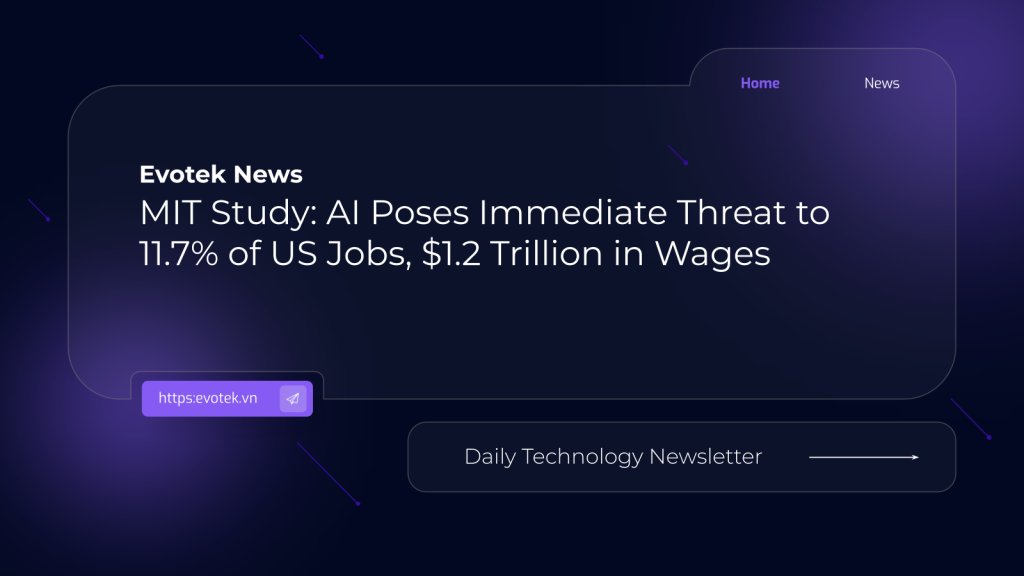A groundbreaking study from the Massachusetts Institute of Technology (MIT) reveals that artificial intelligence (AI) is already capable of replacing 11.7% of the U.S. labor market. This significant finding translates to an staggering $1.2 trillion in wages across key sectors such as finance, healthcare, and professional services.
The comprehensive research, released this Wednesday, leverages an innovative labor simulation tool known as the Iceberg Index. Developed collaboratively by MIT and Oak Ridge National Laboratory (ORNL), this powerful index is designed to model the intricate interactions of 151 million U.S. workers and assess their vulnerability to AI and related policy shifts.
Understanding the Iceberg Index: A Digital Twin of the U.S. Workforce
Announced earlier this year, the Iceberg Index offers a forward-looking perspective on how AI will reshape employment, extending its reach far beyond conventional tech hubs to every state in the nation. It provides an invaluable, granular map for policymakers to identify areas of potential disruption, right down to the zip code level, as they prepare for multi-billion-dollar investments in workforce reskilling and training initiatives.
“Essentially, we are creating a digital twin for the U.S. labor market,” explained Prasanna Balaprakash, ORNL Director and co-leader of the research. ORNL, a Department of Energy research center in eastern Tennessee, harnesses the power of the Frontier supercomputer to fuel these large-scale modeling efforts.
The index conducts population-level experiments, uncovering how AI can fundamentally alter tasks, required skills, and labor flows long before these changes manifest in the broader economy. It meticulously maps over 32,000 skills across 923 occupations within 3,000 counties, precisely measuring where current AI systems can already perform these tasks.
Beyond the Visible: The True Scale of AI’s Impact
What the researchers uncovered challenges common perceptions about AI’s immediate impact. The visible “tip of the iceberg”—represented by layoffs and role shifts in tech, computing, and information technology—accounts for just 2.2% of total wage exposure, approximately $211 billion.
However, beneath this surface lies the colossal total exposure of $1.2 trillion in wages. This deeper layer encompasses routine functions in critical areas often overlooked in traditional automation forecasts, including:
- Human resources
- Logistics
- Finance
- Office administration
The Iceberg Index is not presented as a definitive prediction engine for job losses. Instead, its purpose is to provide a detailed, skills-centered snapshot of what today’s AI systems are already capable of. This allows policymakers to systematically explore various “what-if” scenarios, enabling informed decision-making before committing substantial funding and legislation.
Proactive Policy: States Partnering with the Iceberg Index
The research team has actively partnered with state governments to run proactive simulations, validating the model and helping build policy scenarios. Tennessee, North Carolina, and Utah have collaborated by sharing their labor data and are now leveraging the platform for strategic planning.
Tennessee has already demonstrated leadership, citing the Iceberg Index in its official AI Workforce Action Plan, released this month. Similarly, Utah state leaders are preparing to publish a report based on the Iceberg’s compelling modeling.
North Carolina State Senator DeAndrea Salvador, a close collaborator on the project, highlighted the research’s unique ability to uncover effects missed by traditional analytical tools. She particularly praised the index’s capacity to drill down to granular local details.
“One of the things that you can go down to is county-specific data to essentially say, within a certain census block, here are the skills that is currently happening now and then matching those skills with what are the likelihood of them being automated or augmented, and what could that mean in terms of the shifts in the state’s GDP in that area, but also in employment,” Senator Salvador explained. She emphasized that such simulation work is invaluable as states establish numerous AI task forces and working groups.
Challenging Assumptions and Enabling Future Preparedness
A significant finding from the Iceberg Index is its challenge to the common assumption that AI risk is confined to tech roles in coastal urban centers. The index’s simulations demonstrate that exposed occupations are distributed across all 50 states, including inland and rural regions often absent from the broader AI discourse.
To bridge this gap, the Iceberg team has developed an interactive simulation environment. This tool empowers states to experiment with different policy levers, such as reallocating workforce development funds, adjusting training programs, and exploring how varying levels of technology adoption might impact local employment and gross domestic product.
“Project Iceberg enables policymakers and business leaders to identify exposure hotspots, prioritize training and infrastructure investments, and test interventions before committing billions to implementation,” the official report states.
Balaprakash, who also serves on the Tennessee Artificial Intelligence Advisory Council, shared state-specific findings with Tennessee’s governor and AI director. He noted that many of Tennessee’s core sectors—health care, nuclear energy, manufacturing, and transportation—still rely heavily on physical work, offering some insulation from purely digital automation. The critical question, he added, is how to strategically deploy new technologies like robotics and AI assistants to strengthen these industries, rather than undermining them.
The team views the Iceberg Index not as a finished product, but as an evolving “sandbox.” This dynamic environment allows states to proactively prepare and experiment with various scenarios as they navigate the transformative impact of AI on their workforces.

 日本語
日本語 한국어
한국어 Tiếng Việt
Tiếng Việt 简体中文
简体中文